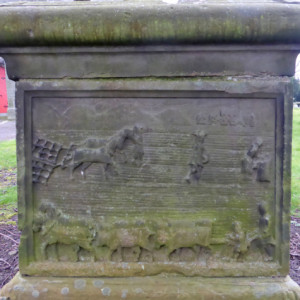The churchyard surrounding Liberton Kirk contains very many interesting old gravestones and one of the most unusual is the Straiton tablestone. In barely discernible writing covered with lichen is inscribed
Here lyes interred Mrs. Katharine Hamelton spouse to William Straiton She died October 29 1753 aged 45 years as also William Straiton hir husband breuer and burgess of Edinburgh and fermer in Braid who departed this life February 17 1754 aged 48 years and thre of their children who al died young.
There are fascinating carvings on the four sides and also inside the end panels. It was not uncommon to indicate the occupation of the deceased and one end panel shows farming scenes (extra) depicting different seasons in farming. At the top with the distant Pentland Hills and a farm in the background, are figures sowing and harrowing with horses, and below some people are ploughing with oxen.
Presumably as a wealthy burgess, William Straiton had men to do these jobs but probably the elegantly costumed figure in the left panel, holding sheaves of corn under his arms and in his hands represents him and signifies his wealth from farming and brewing. On the right hand panel of the supporting balusters it shows the skeletal figure of Death holding a dart, and about to cut the weighted 'thread of life' which hangs above a seated figure. The skeleton frequently appears on 18th-century tombstones. When it is portrayed standing, with the weapons of Death, the dart, spear, scythe or lance, it is the personification of Death, the 'King of Terrors', an ever-present menace.
Below the tablestone is an effigy of William Straiton holding a skull in his hand with his feet resting on a lamb and his head on a sheaf of corn.
Despite being over 260 years old the very elaborate carvings are still in remarkable condition and must have cost a great amount perhaps the equivalent of several years wages for a ploughman.
(Gravestone 4)

Comments
Sign in or get an account to comment.


